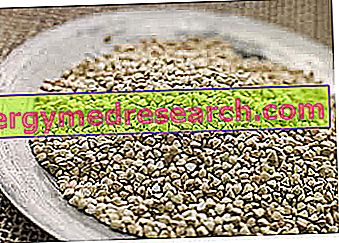Definition
Enzymes are proteins produced in plant and animal cells, which act as catalysts by accelerating biological reactions without being modified.
The enzymes work by combining with a specific substance to transform it into a different substance; classic examples are given by the digestive enzymes present in saliva, in the stomach, in the pancreas and in the small intestine, which perform an essential function in digestion and help to break down foods into the basic constituents, which can then be absorbed and used by the body, processed by other enzymes or expelled as waste.
Each enzyme has a specific role: the one that breaks down fats, for example, does not affect proteins or carbohydrates. Enzymes are essential for the well-being of the organism. Deficiency, even of a single enzyme, can cause serious disorders. A fairly well-known example is phenylketonuria (PKU), a disease characterized by the inability to metabolize an essential amino acid, phenylalanine, the accumulation of which can cause physical deformities and mental illnesses.
Biochemical analysis
Enzymes are particular proteins that have the characteristic of being biological catalysts, that is, they have the ability to reduce the activation energy (Eatt) of a reaction, changing its path to make a kinetically slow process appear faster.
Enzymes increase the kinetics of thermodynamically possible reactions and, unlike catalysts, are more or less specific: they therefore possess substrate specificity.
The enzyme is not involved in the stoichiometry of the reaction: for this to happen, it is essential that the final catalytic site is identical to the starting one.
In the catalytic action, there is almost always a slow phase that determines the speed of the process.
When we talk about enzymes it is not correct to speak of equilibrium reactions, we speak instead of a steady state (state in which a certain metabolite is formed and consumed continuously, maintaining its concentration almost constant over time). The product of a reaction catalyzed by an enzyme is usually itself a reactant for a subsequent reaction, catalyzed by another enzyme, and so on.
Enzyme-catalyzed processes are usually made up of sequences of reactions.
A generic reaction catalyzed by an enzyme (E), can thus be schematized:

A generic enzyme (E) combines with the substrate (S) to form the adduct (ES) with a speed constant K1; it can disassociate again in E + S, with a velocity constant K2, or, (if "lives" long enough) it can proceed to form P with a velocity constant K3.
The product (P) can, in turn, recombine with the enzyme and reform the adduct with speed constant K4.
When enzyme and substrate are mixed, there is a fraction of time in which the meeting between the two species has not yet occurred: that is, there is an extremely short time interval (which depends on the reaction) in which enzyme and substrate have not yet met; after this period, the enzyme and substrate come into contact in increasing quantities and the ES adduct is formed. Subsequently the enzyme acts on the substrate and the product is released. It can then be said that there is an initial time interval in which the concentration of the ES adduct is not definable; after this period, it is assumed that a steady state is established, ie the speed of the processes leading to the adduct is equal to the speed of the processes leading to the destruction of the adduct.
The Michaelis-Menten constant (KM) is an equilibrium constant (referred to the first equilibrium described above); we can say, with good approximation (because K3 should also be considered) that KM is represented by the ratio between the kinetic constants K2 and K1 (referring to the destruction and formation of the adduct ES in the first equilibrium described above).
Through the Michaelis-Menten constant we have an indication of the affinity between enzyme and substrate: if the KM is small there is a high affinity between enzyme and substrate, so the ES adduct is stable.
Enzymes are subject to regulation (or modulation).
In the past there was talk above all of negative modulation, that is of inhibition of the catalytic capacities of an enzyme, but one can also have a positive modulation, that is, there are species capable of enhancing the catalytic capacities of an enzyme.
There are 4 types of inhibitions (obtained from approximations made on a model to match the experimental data with the mathematical equations):
- competitive inhibition
- non-competitive inhibition
- Incompetitive inhibition
- acompetitive inhibition
There is talk of competitive inhibition when a molecule (inhibitor) is able to compete with the substrate. By structural similarity, the inhibitor can react in place of the substrate; this is where the term "competitive inhibition" comes from. The probability that the enzyme binds to the inhibitor or substrate depends on the concentration of both and their affinity with the enzyme; the reaction speed depends on these factors.
To obtain the same reaction rate that would occur without the presence of the inhibitor, it is necessary to have a higher substrate concentration.
It is shown experimentally that, in the presence of an inhibitor, the Michaelis-Menten constant increases.
As regards, instead, the non-competitive inhibition, the interaction between the molecule that should work as a modulator (positive or negative-inhibitor) and the enzyme, occurs in a site that is different from the one in which the interaction between enzyme and substrate; we therefore speak of allosteric modulation (from the Greek allosteros → other site).
If the inhibitor goes to bind to the enzyme, it can induce a modification of the structure of the enzyme and, consequently, it can decrease the efficiency with which the substrate binds to the enzyme.
In this type of process, the Michaelis-Menten constant remains constant since this value depends on the equilibria between enzyme and substrate and, these equilibria, even in the presence of an inhibitor, do not change.
The phenomenon of incompetent inhibition is rare; a typical incompetent inhibitor is a substance that reversibly binds to the ES adduct giving rise to ESI:

Inhibition of excess substrate can sometimes be of an incompetent type, as this occurs when a second substrate molecule binds to the ES complex, giving rise to the ESS complex.
An acompetitive inhibitor, on the other hand, can only bind to the substrate enzyme adduct as in the previous case: the binding of the substrate to the free enzyme induces a conformational modification that makes the site accessible to the inhibitor.
The Michaelis Menten constant decreases with increasing inhibitor concentration: apparently, therefore, the affinity of the enzyme to the substrate increases.
Serine proteases
They are a family of enzymes to which chimotripsin and trypsin belong.
Chymotrypsin is a proteolytic and hydrolytic enzyme that cuts hydrophobic and aromatic amino acids to the right.
The product of the gene that codes for chymotrypsin is not active (it is activated with a command); the non-active form of chymotrypsin is represented by a polypeptide chain of 245 amino acids. Chymotrypsin has a globular shape due to five disulfide bridges and other minor interactions (electrostatic, Van der Waals forces, hydrogen bonds, etc.).
The chymotrypsin is produced by the chimatic cells of the pancreas where it is contained in special membranes and expelled through the pancreatic duct into the intestine, at the time of digestion of the food: the chymotrypsin is in fact a digestive enzyme. The proteins and nutrients that we ingest through the diet are subjected to digestion to be reduced to smaller chains and to be absorbed and transformed into energy (eg amylases and proteases split the nutrients into glucose and amino acids that reach the cells, through the blood vessels they reach the portal vein and from there they are conveyed to the liver where they undergo further treatments).
Enzymes are produced in an inactive form and are activated only when they reach the "site where they must operate"; when their action is over, they are deactivated. An enzyme, once deactivated, cannot be reactivated: to have an additional catalytic action, it must be replaced by another enzyme molecule. If the chimitripsina were already produced in an active form in the pancreas, it would attack the latter: pancreatitis are pathologies due to digestive enzymes that are already activated in the pancreas (and not in the required locations); some of them if not treated in time, lead to death.
In the chymotrypsin and in all the serine proteases, the catalytic action is due to the existence of the alkolate anion (-CH2O-) in the side chain of a serine.
The serine proteases take this name precisely because their catalytic action is due to a serine.
Once all the enzyme has performed its action, before being able to re-operate on the substrate again, it must be restored with water; the "liberation" of serine by water is the slowest stage in the process, and it is this phase that determines the speed of catalysis.
The catalytic action occurs in two phases:
- anion formation with catalytic properties (alkolate anion) and subsequent nucleophilic attack to the carbonyl carbon (C = O) with cleavage of the peptide bond and ester formation;
- attack of the water with recovery of the catalyst (able, thus to again exercise its catalytic action).
The various enzymes that belong to the family of serine proteases can be made up of different amino acids but, for all, the catalytic site is represented by the alkolate anion of the side chain of a serine.
A subfamily of serine proteases is that of the enzymes involved in coagulation (which consists in the transformation of protein, from their inactive form to another form that is active). These enzymes ensure that the coagulation is as effective as possible and is limited in space and time (coagulation must occur quickly and must occur only near the injured area). The enzymes involved in the coagulation, are activated in cascade (from the activation of a single enzyme, billions of enzymes are obtained: every enzyme activated, in turn activates many other enzymes).
Thrombosis is a disease due to the malfunctioning of coagulation enzymes: it is caused by activation, without necessity (because there is no lesion), of the enzymes used in coagulation.
There are modulating enzymes (regulators) and inhibitory enzymes for other enzymes: by interacting with the latter they regulate or inhibit their activity; even the product of an enzyme can be an inhibitor for the enzyme. There are also enzymes that work the more, the greater the substrate present.
Lysozyme
Luigi Pasteur discovered, by chance, sneezing on a petri dish, that in the mucus there is an enzyme capable of killing bacteria: lysozyme ; from the Greek: liso = which cuts; zimo = enzyme.
Lysozyme is capable of breaking the cell wall of bacteria. Bacteria and, in general, single-celled organisms, need mechanically resistant structures that limit their shape; inside the bacteria there is a very high osmotic pressure therefore they attract water. The plasma membrane would explode if there were no cell wall that opposes the entry of water and limits the volume of the bacterium.
The cell wall consists of a polysaccharide chain in which N-acetyl-glucosamine (NAG) molecules and N-acetyl-muramic acid (NAM) molecules alternate; the link between NAG and NAM breaks down by hydrolysis. The NAM carboxyl group in the cell wall is engaged in a peptide bond with an amino acid.
Between the various chains bridges are formed consisting of pseudo-peptide bonds: the branching is due to the lysine molecule; the structure as a whole is very branched and this gives it high stability.
Lysozyme is an antibiotic (it kills bacteria): it acts by making a crack in the bacterial wall; when this structure is broken (which is mechanically resistant) the bacterium attracts water until it bursts. Lysozyme is able to break the b-1, 4 glucosidic bond between NAM and NAG.
The catalytic site of the lysozyme is represented by a groove that runs along the enzyme into which the polysaccharide chain is inserted: six glucosidic rings of the chain, find their place in the groove.
In position three of the groove there is a bottleneck: in this position only one NAG can be placed, because the NAM, which is larger, cannot enter. The actual catalytic site is between positions four and five: there being a NAG in position three, the cut will take place between a NAM and a NAG (and not vice versa); therefore, the cut is specific.
The optimum pH for the functioning of lysozyme is five. In the catalytic site of the enzyme, that is between positions four and five, there are the side chains of an aspartic acid and a glutamic acid.
Degree of homology : measures the relationship (ie the similarity) between protein structures.
There is a strong relationship between lysozyme and lactose-synthetase.
Lactose synthase synthesizes lactose (which is the main sugar in milk): lactose is a galactosyl glucoside in which there is a β-1, 4 glucosidic bond between galactose and glucose.
Thus, lactose synthetase catalyzes the reaction opposite to that catalyzed by lysozyme (which instead breaks down the β-1, 4 glucosidic bond)
Lactose synthase is a dimer, that is, it consists of two protein chains, one of which has catalytic properties and is comparable to lysozyme and the other is a regulatory subunit.
During pregnancy, glycoproteins are synthesized from mammary gland cells by the action of galatosyl-tranferase (it has a 40% sequence homology with lysozyme): this enzyme is able to transfer a galactosyl group from a high-energy structure to a glycoprotein structure. During pregnancy, the expression of the gene coding for galactosis-transferase is induced (there is also the expression of other genes that also give other products): there is an increase in the size of the breast because the mammary gland is activated (previously not active) which must produce milk. During childbirth, α-lactalalbumin is produced which is a regulatory protein: it is able to regulate the catalytic capacity of galactosyl-transferase (due to substrate discrimination). The galactosyl-transferase modified by α-lactalalbumin, is able to transfer a galactosyl on a glucose molecule: forming a β-1, 4 glycosidic bond and giving lactose (lactose synthetase).
Thus, galactose transferase prepares the mammary gland before delivery and produces milk after delivery.
To produce glycoproteins, galactosyltransferase binds to a galactosyl and a NAG; during birth, lactal albumin binds to galactosyltransferase, causing the latter to recognize glucose rather than NAG to give lactose.



